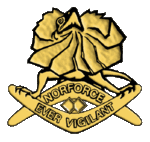- NORFORCE
-
North-West Mobile Force 
Cap Badge of the North-West Mobile ForceActive 1 July 1981 – Present Country  Australia
AustraliaBranch Army Role Regional Force Surveillance Size One battalion Part of 6th Brigade Garrison/HQ Larrakeyah Nickname Nackaroos
Green skinsMotto Ever Vigilant March Quick - The Vedette
Slow - The Never-NeverCommanders Colonel in Chief HM The Queen
(Royal Australian Infantry Corps)Insignia Unit Colour Patch Abbreviation NORFORCE Area of Operations
The NORFORCE (North-West Mobile Force) is an infantry regiment of the Australian Army Reserve. Formed in 1981, the regiment is one of three Regional Force Surveillance Units (RFSUs) employed in surveillance and reconnaissance of the remote areas of Northern Australia.
Contents
History
In the late-1970s and early 1980s the need for a military presence in the north of Australia was recognised, with an integrated land, sea and air surveillance network developed in response. Part of this involved the raising of reserve infantry units that would act as "eyes and ears" in the north.[1] NORFORCE was raised for operations in the Northern Territory and the Kimberly region of northern Australia[2] and was originally formed as a company on 1 July 1981, from the 7th Independent Rifle Company, based in Darwin under Lieutenant Colonel John George. This was renamed as the North-West Mobile Force, or NORFORCE, in 1981.[2] Meanwhile in 1985 two more RFSUs were raised, with the Pilbara Regiment established in Western Australia, and the 51st Battalion, Far North Queensland Regiment established in Cape York, in Far North Queensland.[3]
The regiment's lineage goes back to 2/1st North Australia Observer Unit (also known as the "Nackaroos"), which were formed in 1942 as part of the defence of northern Australia from the Japanese during the Second World War, performing reconnaissance, scouting and coastal surveillance tasks across the Kimberley and the Northern Territory's sea and air approaches. However, patrols were reduced in July 1943 as the Japanese threat subsided, and the unit was disbanded in 1945.[4][3] Due to the similarities between the two units and in order to give NORFORCE an identity it was decided that it would perpetuate the NAOU traditions, and as such NORFORCE officially adopted the NAOU's orange and green 'double diamond' colour patch and its unit heritage upon formation.[3]
NORFORCE also shares its heritage with a number of other units raised during the Second World War, including the Darwin Mobile Force, from which NORFORCE derives its name, and the Northern Territory Special Reconnaissance Unit which performed a similar role to the NAOU and pioneered the enlistment and training of regionally based Aboriginal soldiers, mainly from Arnhem Land. The Darwin Mobile Force was raised in 1939, originally as an artillery unit due to restrictions of the Defence Act (1903) which prohibited the establishment of permanent infantry forces, and was the first Permanent Military Force unit to be raised in the Army. The unit was tasked with the surveillance and protection of the Darwin region. Later renamed the Darwin Infantry Battalion in 1942, in 1943 it was again re-named the 19th Battalion, and subsequently saw service during the New Guinea campaign.[3][5]
Today, the regiment is based at Larrakeyah Barracks in Darwin, while its area of operation covers 1.8 million square kilometres, encompassing the entire Northern Territory and the Kimberley region of Western Australia; the largest of any military unit in the world today.[4] Borrowing the concept of different "skin" groups to differentiate clans, members of NORFORCE are also known as "Green skins".[6] In 2006, the regiment celebrated its 25th birthday by being presented with its first stand of colours.[7] On 1 March 2010, NORFORCE became part of the re-raised 6th Brigade.[8] The primary role of the regiment is reconnaissance, observation and the collection of military intelligence. In the unlikely event of an invasion of northern Australia, NORFORCE and the other RFSUs would operate in a "stay-behind" capacity.[9] 60% of NORFORCE personnel are Australian Aboriginal soldiers, drawn mainly from the area they patrol to draw on local knowledge.[10] This has resulted in great trust for the regiment among Aboriginal communities.[11]
See also
Notes
- ^ "Unit History—the Pilbara Regiment". Australian Department of Defence. 2009. http://www.defence.gov.au/ARMY/PILBARA/Unit_History.asp. Retrieved 11 June 2010.
- ^ a b Kuring 2004, p. 390.
- ^ a b c d "Unit History—North West Mobile Force". Australian Department of Defence. 2009. http://www.army.gov.au/norforce/Unit_History.asp. Retrieved 12 June 2010.
- ^ a b "Operation OUTREACH NT". Australian Department of Defence. http://www.defence.gov.au/opEx/global/opoutreach/norforce.htm. Retrieved 8 June 2009.
- ^ Grey 2008, p. 141.
- ^ "Green skin: Australia's indigenous army". Australian Geographic. 7 July 2010. http://www.australiangeographic.com.au/journal/Green-skin-Australia’s-indigenous-army.htm. Retrieved 9 August 2010.[dead link]
- ^ McSweeney, Mike (13 July 2006). "True Colours for NORFORCE". Army News (Australian Army). http://www.defence.gov.au/news/armynews/editions/1147/topstories/story05.htm. Retrieved 08 June 2009.
- ^ Gaze, Jillian (18 March 2010). "Key to Adaptability". Army News (Australian Army). http://digital.realviewtechnologies.com/default.aspx?xml=defencenews_army.xml. Retrieved 20 March 2010.
- ^ J. O. Langtry and Desmond Ball (1991). The Northern Territory in the defence of Australia: strategic and operational considerations. Strategic and Defence Studies Centre, Research School of Pacific Studies, Australian National University. p. 235.
- ^ "Message Stick - Norforce". Australian Broadcasting Corporation. 22 October 2004. http://www.abc.net.au/tv/messagestick/stories/s1222121.htm.
- ^ "Green skin: Australia's indigenous army". Australian Geographic. 7 July 2010. http://www.australiangeographic.com.au/journal/green-skin-australias-indigenous-army.htm.
References
Further reading
- Rosenzweig, Paul A (2001). Ever vigilant : the regimental history of the North West Mobile Force (NORFORCE) 1981–2001. Darwin. ISBN 1876248610.
Categories:- Infantry regiments of Australia
- Military units and formations established in 1981
Wikimedia Foundation. 2010.

